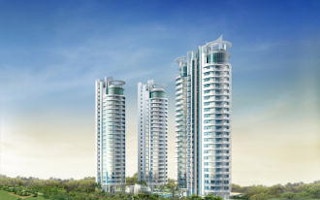The real estate sector’s attitude towards sustainability has undergone a drastic change in the past two decades. From scarcely any awareness of climate change, many companies have become keen proponents of green living, and some are even making active efforts to educate their stakeholders about the concept.
Managing director of property developer City Developments Limited, Kwek Leng Joo, recalls that in the 1990s, when the firm was trying to find like-minded partners “to help us in greening our buildings, it was a great challenge.”
“Today, I can safely say that sustainable development, environmental friendliness and best ESG (environmental, social and governance) practices have become second nature to our industry,” said Mr Kwek, who is also the president of Singapore Compact for CSR.
He was giving a keynote speech on the opening day of the three-day International Green Building Conference held at Marina Bay Sands on Wednesday.
Five key drivers, he said, are behind the transformation of the industry: politics, investor activism, risk management, positive branding and public pressure.
Citing the proliferation of social media and the increasing readiness of stakeholders – investors, shareholders, NGOs or even unrelated members of the public – to voice their concerns online, Mr Kwek noted that environmental, health and safety, and workplace issues have attracted growing comments, pushing companies to take action.
Businesses, he said, must be prepared to address increased shareholder expectations in order to mitigate ESG-related risks. He added that he has witnessed companies gaining a greater awareness of the importance of sustainable development.
He also dismissed claims that green practices do not make business sense.
“Based on CDL’s experience, there is definitely a business case for going green,” said Mr Kwek, citing CDL’s Green Mark buildings, which accounted for electricity savings of an estimated S$19.7 million between 2008 and 2011.
According to a study by the National University of Singapore, each green building is expected to generate an average savings of 10 per cent of operating expenses and 17 per cent of energy consumption, as well as a 2 per cent increase in capital value.
On top of this, he pointed out, CDL’s sustainability efforts have gained it local and international brand reputation for sustainability. This reputation, and the consumer trust that accompanies it, are priceless, he said.
Green communities
For sustainability to happen, various stakeholder groups have to come together and take shared responsibility over the entire life cycle of a building, said Professor Jacqueline Cramer, director of the Utrecht Sustainable Institute. This includes regulators, employees, shareholders, media, investors, supply chain partners and even the community at large.
“Think global but act local,” said Professor Cramer, who was speaking at the same plenary session as Mr Kwek. Earlier, she shared some of the issues European countries face in greening residential buildings. These include lack of community awareness and a split between financial, institutional and administrative incentives to get the ball rolling.
For this reason, speakers suggested that developing green communities is the best way to spread change in the real estate industry.
Ms Yuko Nishida, planner for the Tokyo Metropolitan Government’s Bureau of Environment, said that building owners need to play a part by including various stakeholders in their measures to make buildings sustainable.
For example, she suggested, they should appreciate the knowledge that their on-site engineers and facility managers possess, and actively seek out solutions from these people. At the same time, policymakers should gather data on sustainability and support building owners’ understanding of the data.
Her recommendations are based on observations from Tokyo Cap and Trade, Asia’s first urban cap-and-trade emissions reduction scheme.
The scheme targets 1,300 urban facilities consuming large amounts of energy, requiring them to reduce their emissions by 6 to 8 per cent from a base year. Reductions above that amount can be traded with other participants in the scheme. Tokyo Cap and Trade has been highly successful so far, with total emissions from participating buildings reduced by 13 per cent.
Closer to home, CDL’s Mr Kwek said that his company has been pursuing a first generation green strategy since the 1990s, bearing in mind that the change to an eco-friendly mindset has to be cultivated over the long term.
CDL invests about 2 to 5 per cent of each building’s construction cost in green design features and actively encourages its tenants and buyers to participate in green initiatives, such as raising the air conditioning temperature of commercial facilities by one degree.
He added that CDL also intends to use its influence to transform the larger community, leveraging on the interconnectedness of various sectors: retail, services, manufacturing and so on.
“We believe that the next step is moving from focusing primarily on this industry, to touching the community at large,” said Mr Kwek. “Green buildings are only one piece of the larger puzzle.”
Eco-Business.com’s coverage of the International Green Building Conference 2012 is brought to you by City Developments Limited.
For other news from the Singapore Green Building Week, including the International Green Building Conference 2012 and Bex Asia 2012, click here.










